Huijun Di
M^3Detection: Multi-Frame Multi-Level Feature Fusion for Multi-Modal 3D Object Detection with Camera and 4D Imaging Radar
Oct 31, 2025Abstract:Recent advances in 4D imaging radar have enabled robust perception in adverse weather, while camera sensors provide dense semantic information. Fusing the these complementary modalities has great potential for cost-effective 3D perception. However, most existing camera-radar fusion methods are limited to single-frame inputs, capturing only a partial view of the scene. The incomplete scene information, compounded by image degradation and 4D radar sparsity, hinders overall detection performance. In contrast, multi-frame fusion offers richer spatiotemporal information but faces two challenges: achieving robust and effective object feature fusion across frames and modalities, and mitigating the computational cost of redundant feature extraction. Consequently, we propose M^3Detection, a unified multi-frame 3D object detection framework that performs multi-level feature fusion on multi-modal data from camera and 4D imaging radar. Our framework leverages intermediate features from the baseline detector and employs the tracker to produce reference trajectories, improving computational efficiency and providing richer information for second-stage. In the second stage, we design a global-level inter-object feature aggregation module guided by radar information to align global features across candidate proposals and a local-level inter-grid feature aggregation module that expands local features along the reference trajectories to enhance fine-grained object representation. The aggregated features are then processed by a trajectory-level multi-frame spatiotemporal reasoning module to encode cross-frame interactions and enhance temporal representation. Extensive experiments on the VoD and TJ4DRadSet datasets demonstrate that M^3Detection achieves state-of-the-art 3D detection performance, validating its effectiveness in multi-frame detection with camera-4D imaging radar fusion.
SFGFusion: Surface Fitting Guided 3D Object Detection with 4D Radar and Camera Fusion
Oct 22, 2025Abstract:3D object detection is essential for autonomous driving. As an emerging sensor, 4D imaging radar offers advantages as low cost, long-range detection, and accurate velocity measurement, making it highly suitable for object detection. However, its sparse point clouds and low resolution limit object geometric representation and hinder multi-modal fusion. In this study, we introduce SFGFusion, a novel camera-4D imaging radar detection network guided by surface fitting. By estimating quadratic surface parameters of objects from image and radar data, the explicit surface fitting model enhances spatial representation and cross-modal interaction, enabling more reliable prediction of fine-grained dense depth. The predicted depth serves two purposes: 1) in an image branch to guide the transformation of image features from perspective view (PV) to a unified bird's-eye view (BEV) for multi-modal fusion, improving spatial mapping accuracy; and 2) in a surface pseudo-point branch to generate dense pseudo-point cloud, mitigating the radar point sparsity. The original radar point cloud is also encoded in a separate radar branch. These two point cloud branches adopt a pillar-based method and subsequently transform the features into the BEV space. Finally, a standard 2D backbone and detection head are used to predict object labels and bounding boxes from BEV features. Experimental results show that SFGFusion effectively fuses camera and 4D radar features, achieving superior performance on the TJ4DRadSet and view-of-delft (VoD) object detection benchmarks.
FloNa: Floor Plan Guided Embodied Visual Navigation
Dec 24, 2024Abstract:Humans naturally rely on floor plans to navigate in unfamiliar environments, as they are readily available, reliable, and provide rich geometrical guidance. However, existing visual navigation settings overlook this valuable prior knowledge, leading to limited efficiency and accuracy. To eliminate this gap, we introduce a novel navigation task: Floor Plan Visual Navigation (FloNa), the first attempt to incorporate floor plan into embodied visual navigation. While the floor plan offers significant advantages, two key challenges emerge: (1) handling the spatial inconsistency between the floor plan and the actual scene layout for collision-free navigation, and (2) aligning observed images with the floor plan sketch despite their distinct modalities. To address these challenges, we propose FloDiff, a novel diffusion policy framework incorporating a localization module to facilitate alignment between the current observation and the floor plan. We further collect $20k$ navigation episodes across $117$ scenes in the iGibson simulator to support the training and evaluation. Extensive experiments demonstrate the effectiveness and efficiency of our framework in unfamiliar scenes using floor plan knowledge. Project website: https://gauleejx.github.io/flona/.
Detail-Preserving Transformer for Light Field Image Super-Resolution
Jan 02, 2022
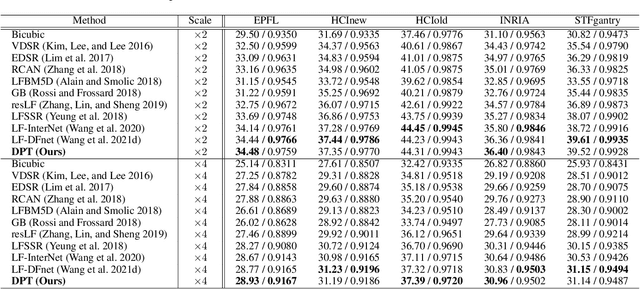
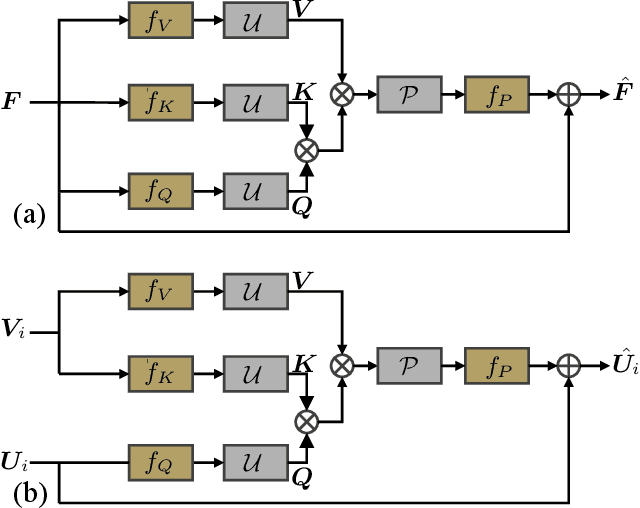
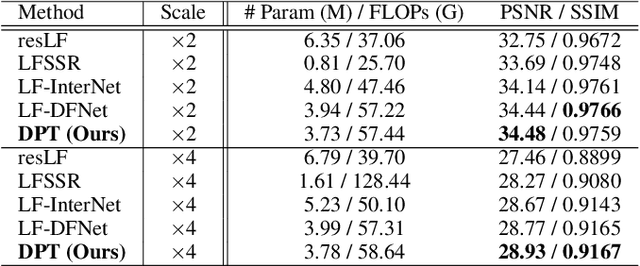
Abstract:Recently, numerous algorithms have been developed to tackle the problem of light field super-resolution (LFSR), i.e., super-resolving low-resolution light fields to gain high-resolution views. Despite delivering encouraging results, these approaches are all convolution-based, and are naturally weak in global relation modeling of sub-aperture images necessarily to characterize the inherent structure of light fields. In this paper, we put forth a novel formulation built upon Transformers, by treating LFSR as a sequence-to-sequence reconstruction task. In particular, our model regards sub-aperture images of each vertical or horizontal angular view as a sequence, and establishes long-range geometric dependencies within each sequence via a spatial-angular locally-enhanced self-attention layer, which maintains the locality of each sub-aperture image as well. Additionally, to better recover image details, we propose a detail-preserving Transformer (termed as DPT), by leveraging gradient maps of light field to guide the sequence learning. DPT consists of two branches, with each associated with a Transformer for learning from an original or gradient image sequence. The two branches are finally fused to obtain comprehensive feature representations for reconstruction. Evaluations are conducted on a number of light field datasets, including real-world scenes and synthetic data. The proposed method achieves superior performance comparing with other state-of-the-art schemes. Our code is publicly available at: https://github.com/BITszwang/DPT.
A Decomposition Model for Stereo Matching
Apr 15, 2021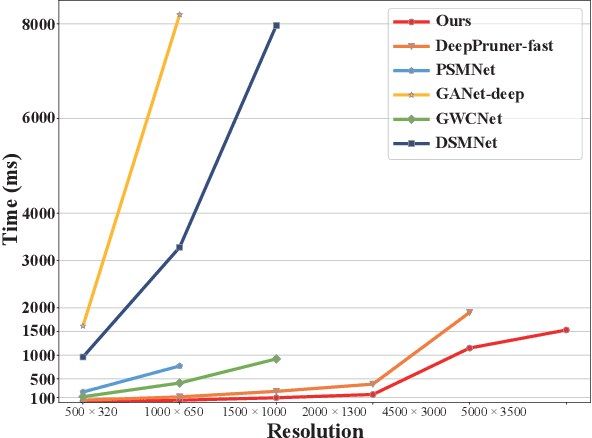
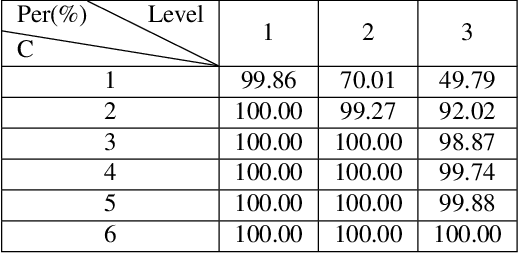
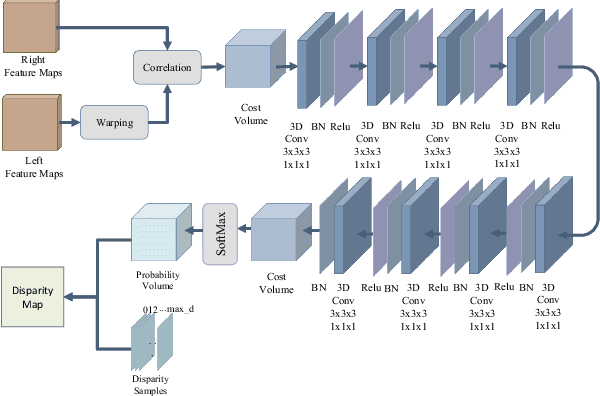

Abstract:In this paper, we present a decomposition model for stereo matching to solve the problem of excessive growth in computational cost (time and memory cost) as the resolution increases. In order to reduce the huge cost of stereo matching at the original resolution, our model only runs dense matching at a very low resolution and uses sparse matching at different higher resolutions to recover the disparity of lost details scale-by-scale. After the decomposition of stereo matching, our model iteratively fuses the sparse and dense disparity maps from adjacent scales with an occlusion-aware mask. A refinement network is also applied to improving the fusion result. Compared with high-performance methods like PSMNet and GANet, our method achieves $10-100\times$ speed increase while obtaining comparable disparity estimation results.
Content-Aware Inter-Scale Cost Aggregation for Stereo Matching
Jun 05, 2020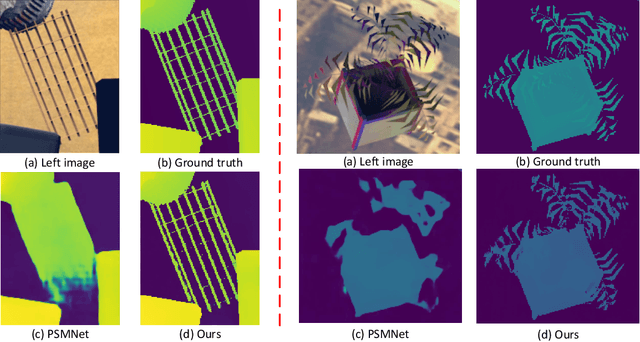

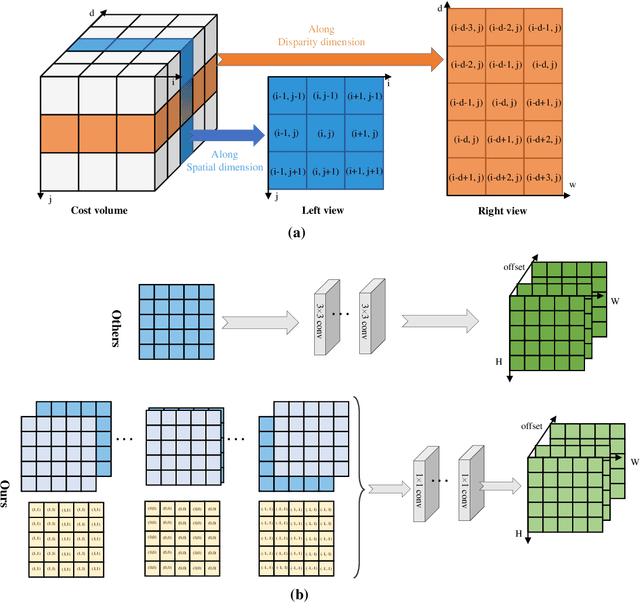

Abstract:Cost aggregation is a key component of stereo matching for high-quality depth estimation. Most methods use multi-scale processing to downsample cost volume for proper context information, but will cause loss of details when upsampling. In this paper, we present a content-aware inter-scale cost aggregation method that adaptively aggregates and upsamples the cost volume from coarse-scale to fine-scale by learning dynamic filter weights according to the content of the left and right views on the two scales. Our method achieves reliable detail recovery when upsampling through the aggregation of information across different scales. Furthermore, a novel decomposition strategy is proposed to efficiently construct the 3D filter weights and aggregate the 3D cost volume, which greatly reduces the computation cost. We first learn the 2D similarities via the feature maps on the two scales, and then build the 3D filter weights based on the 2D similarities from the left and right views. After that, we split the aggregation in a full 3D spatial-disparity space into the aggregation in 1D disparity space and 2D spatial space. Experiment results on Scene Flow dataset, KITTI2015 and Middlebury demonstrate the effectiveness of our method.
Abrupt Motion Tracking via Nearest Neighbor Field Driven Stochastic Sampling
Jan 21, 2015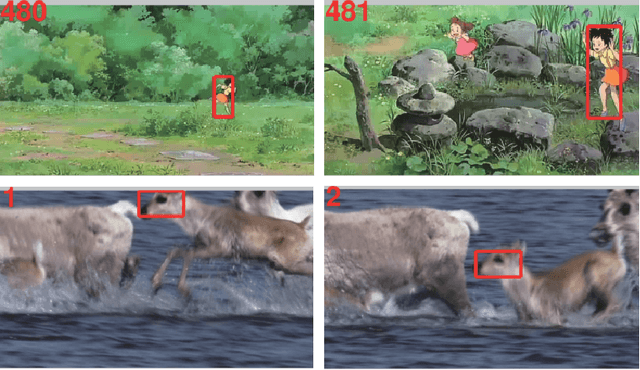
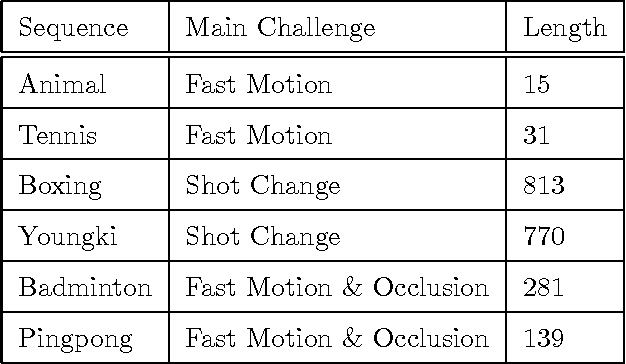

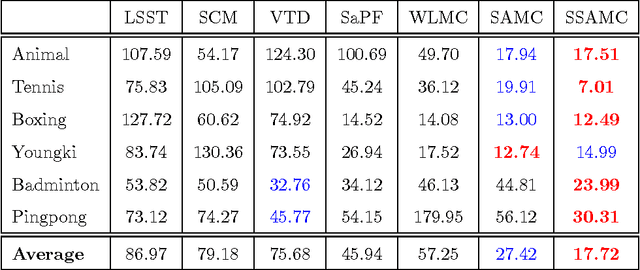
Abstract:Stochastic sampling based trackers have shown good performance for abrupt motion tracking so that they have gained popularity in recent years. However, conventional methods tend to use a two-stage sampling paradigm, in which the search space needs to be uniformly explored with an inefficient preliminary sampling phase. In this paper, we propose a novel sampling-based method in the Bayesian filtering framework to address the problem. Within the framework, nearest neighbor field estimation is utilized to compute the importance proposal probabilities, which guide the Markov chain search towards promising regions and thus enhance the sampling efficiency; given the motion priors, a smoothing stochastic sampling Monte Carlo algorithm is proposed to approximate the posterior distribution through a smoothing weight-updating scheme. Moreover, to track the abrupt and the smooth motions simultaneously, we develop an abrupt-motion detection scheme which can discover the presence of abrupt motions during online tracking. Extensive experiments on challenging image sequences demonstrate the effectiveness and the robustness of our algorithm in handling the abrupt motions.
 Add to Chrome
Add to Chrome Add to Firefox
Add to Firefox Add to Edge
Add to Edge